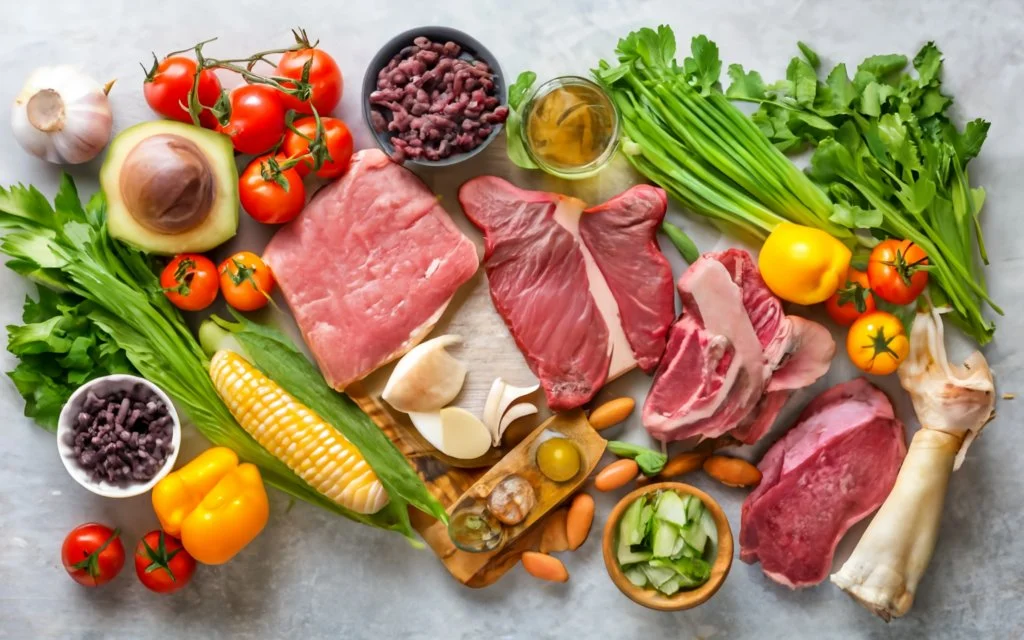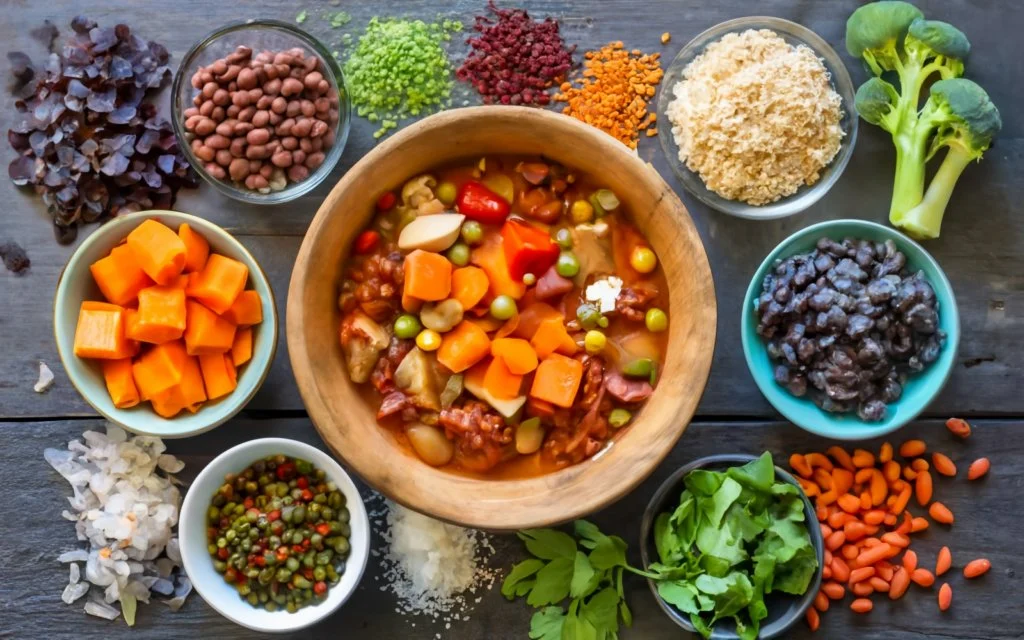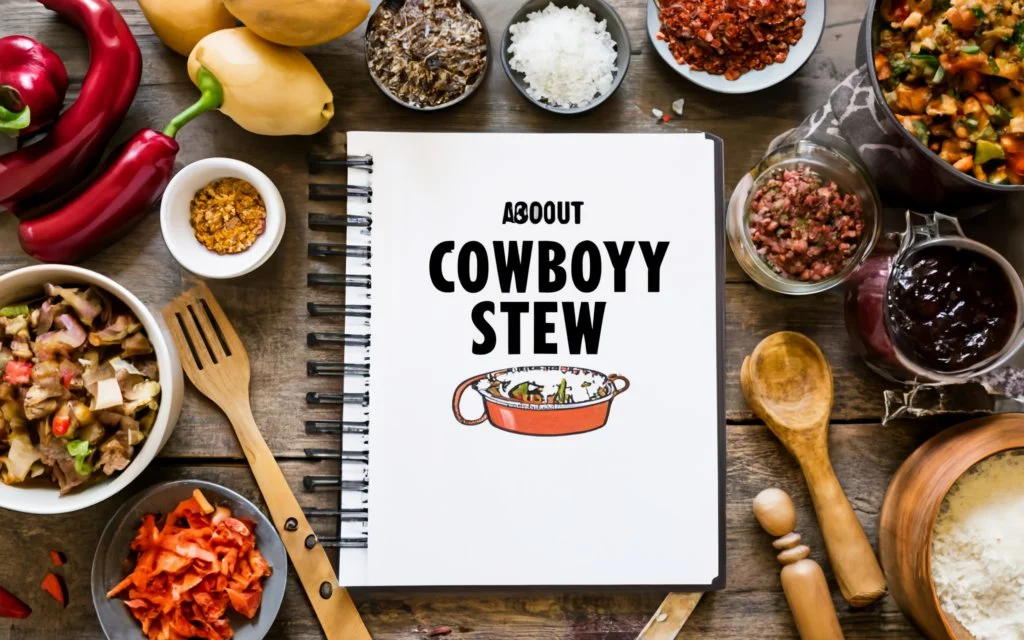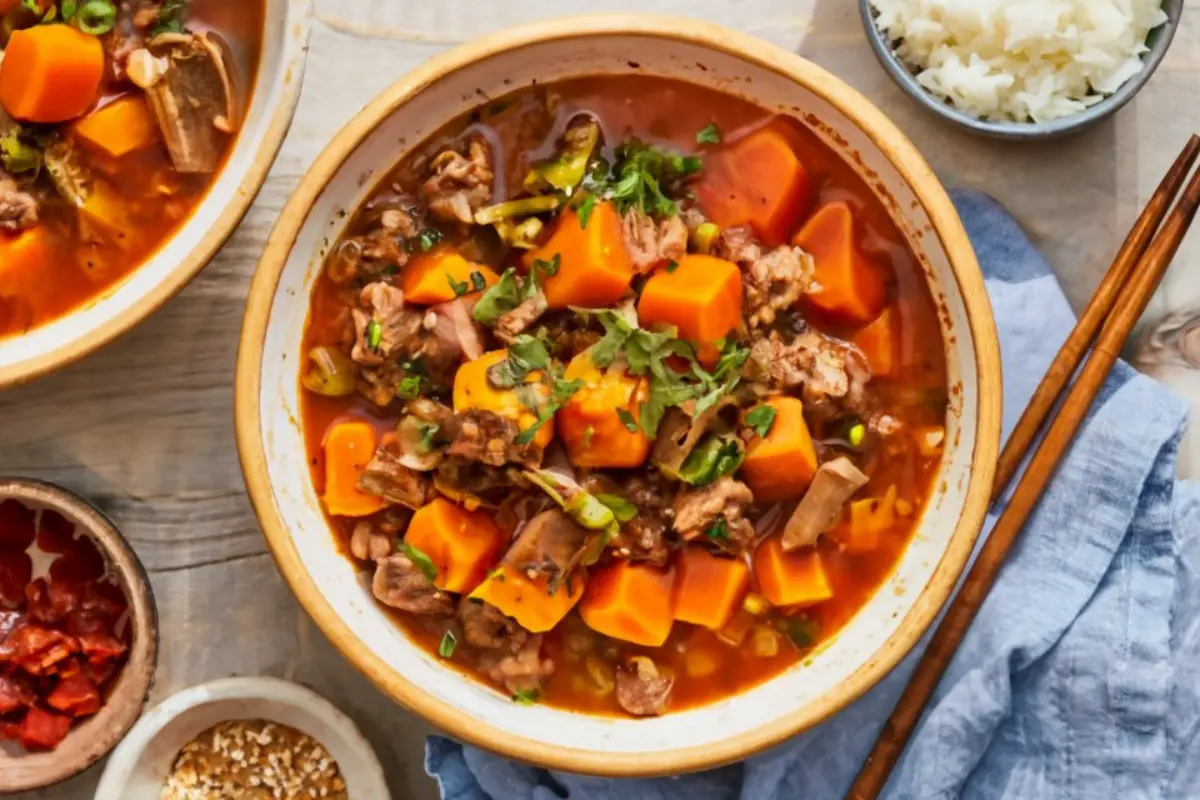Part 1: Introduction to Cowboy Stew

What is Cowboy Stew?
What is cowboy stew made of? This question opens the door to a culinary adventure steeped in American cuisine – Wikipedia. Essentially, cowboy stew is a hearty concoction that combines meat, beans, tomatoes, corn, and onions into a rich, flavorful dish. It’s a versatile recipe that allows for various meats and vegetables, making it a staple in many households.
The Rich History
Initially, cowboy stew served as a practical solution for cowboys on long Cattle Trail Stew Evolution. They needed a meal that was not only filling but also easy to prepare with limited resources. Over time, this necessity-based dish evolved into a comfort food beloved by many, transcending its humble origins to become a symbol of American resilience and ingenuity.
A Closer Look at Ingredients
At its core, the stew is a celebration of simplicity and flavor. The meat—beef or pork—provides a robust base, while beans add heartiness and texture. Tomatoes and corn introduce a sweet tanginess, and onions offer a foundational aroma. Spices like chili powder and cumin bring warmth and depth, tying all the elements together. Read more: Exploring Piquillo Peppers: Culinary Benefits & Recipes
Evolution Over Time
Moreover, cowboy stew has adapted over the years, incorporating new ingredients and variations to suit changing tastes and short history of American food (whatever that is) Today, it’s more than just a meal; it’s a piece of culinary history, a testament to the adaptability and creativity of those who first cooked it under the open sky.
Part 2: Ingredients of Cowboy Stew

Diving Into the Basics
When pondering, “What is cowboy stew made of?” we uncover a blend of hearty and robust ingredients. Central to the stew are meats like beef or pork, providing a rich, flavorful foundation. Beans, such as pinto or kidney, add not only texture but also a hearty dose of protein and fiber, making the stew both filling and nutritious.
Vegetables and Spices
Vegetables play a crucial role, with diced tomatoes and corn adding a sweet tanginess and vibrant color. Onions and garlic contribute a depth of flavor, essential for that homely, comforting taste. The spices, particularly chili powder and cumin, introduce warmth and a subtle kick, elevating the stew from simple to sublime.
Adapting and Personalizing
Interestingly, cowboy stew celebrates versatility. Feel free to throw in bell peppers for a bit of crunch or potatoes for extra heartiness. Some might even add a splash of beer or broth to deepen the flavor profile. This adaptability means you can tailor the stew to your taste preferences or dietary needs, making it a perfect dish for any table. suggesting a specific recipe that could Marry Me Chicken Recipe
A Dish for All
In summary, cowboy stew is a testament to the simplicity and richness of American cooking. Its ingredients reflect a blend of cultures and traditions, coming together in a pot of comforting, flavorful goodness. Whether you stick to the traditional recipe or add your twist, cowboy stew remains a beloved dish that warms the heart and soul.
Part 3: Crafting Cowboy Stew
The Cooking Process
Embarking on the journey to create cowboy stew begins with browning your chosen meat. This step is pivotal, as it infuses the stew with a deep, savory flavor. Next, sauté onions and garlic until they’re translucent and aromatic, setting the stage for a rich base.
Adding Depth and Flavor
Following that, introduce diced tomatoes, beans, and corn into the mix. These ingredients work together, adding layers of flavor and texture. As for the spices—chili powder, cumin, and a touch of salt—are essential. They bring warmth and complexity to the stew, making it truly authentic.
Simmering to Perfection
After combining all the ingredients, let the stew simmer. This slow cooking method allows the flavors to meld beautifully. Remember, patience is key here. A slow simmer brings out the best in the stew, enriching its taste and aroma.
Final Touches
Before serving, taste and adjust the seasoning as necessary. Sometimes, a little extra salt or a dash of spice can elevate the stew from good to great. This final step ensures your cowboy stew is not just made but crafted with care and attention to detail.
Conclusion
In essence, making cowboy stew is an art that celebrates the richness of simple ingredients. Through each step of the process, from browning the meat to the final seasoning, you’re not just cooking; you’re creating a piece of culinary history. This dish, with its deep flavors and hearty texture, is a testament to the enduring appeal of cowboy cuisine.
Part 4: Nutritional Insights and Benefits

A Closer Look at Nutrients
Cowboy stew, with its rich array of ingredients, is not just a treat for the taste buds but also a boon for the body. The meats used, be it beef or pork, are excellent sources of high-quality protein, essential for muscle repair and growth. Moreover, beans add a significant amount of fiber and protein, supporting digestive health and keeping you satiated longer.
Vitamins and Minerals Galore
Furthermore, the vegetables in cowboy stew, like tomatoes and corn, are packed with vitamins, antioxidants, and minerals. These components are crucial for maintaining overall health, boosting the immune system, and combating oxidative stress. Additionally, the spices not only enhance flavor but also offer health benefits, including anti-inflammatory properties.
Adapting for Dietary Needs
Importantly, cowboy stew can be easily modified to suit various dietary preferences and restrictions. For those looking for a leaner option, substituting meat with a leaner cut or a plant-based alternative can reduce fat content without compromising on taste. Similarly, for a gluten-free version, ensuring that all added ingredients are free of gluten is key.
Heart-Healthy Options
To make the stew more heart-friendly, consider using low-sodium broth and fresh tomatoes instead of canned ones to control the salt content. Adding more beans and vegetables can also increase the stew’s fiber content, which is beneficial for heart health.
Conclusion
In essence, cowboy stew is a versatile dish that not only warms the soul but also nourishes the body. By understanding the nutritional content and making informed choices about ingredients, you can enjoy this hearty meal in a way that best suits your health and dietary needs.
Part 5: Serving and Pairing Ideas
Serving Suggestions
Cowboy stew, with its hearty and robust flavors, stands as a complete meal on its own. Yet, the right accompaniments can elevate it from a simple dish to a memorable feast. For an added touch of comfort, consider serving it with a side of warm, crusty bread, perfect for dipping into the rich sauce.
Pairing with Sides
Additionally, a fresh, crisp salad can offer a refreshing contrast to the stew’s richness, adding a burst of color and texture to your meal. For those looking for a heartier option, a side of mashed potatoes or rice can complement the stew, making it even more satisfying.
Beverage Pairings
Moreover, when it comes to beverages, a full-bodied red wine can be an excellent choice, as its robust flavors harmonize beautifully with the stew’s meaty and spicy notes. For a non-alcoholic option, a rich, dark beer or a sparkling apple cider can also pair well, adding an extra layer of flavor to the dining experience.
Creative Serving Ideas
Finally, for a fun and interactive meal, consider serving cowboy stew in individual bread bowls. Not only does this add a unique twist to the presentation, but it also allows guests to enjoy every last bite of this delicious dish.
Conclusion
In summary, cowboy stew is a versatile dish that can be served in numerous ways, each enhancing its hearty flavors. Whether paired with simple sides, matched with the perfect beverage, or presented in a creative manner, cowboy stew is sure to delight and satisfy.
Part 6: FAQs

Can I Make Cowboy Stew in a Slow Cooker?
Absolutely! A slow cooker is perfect for cowboy stew, allowing flavors to meld beautifully over several hours. Just brown your meat beforehand for added depth.
Is Cowboy Stew Gluten-Free?
It can be, with the right ingredients. Ensure your broth and any added thickening agents are gluten-free. Always check labels if you’re using store-bought items.
How Can I Make My Cowboy Stew Vegetarian?
Swap the meat for a plant-based protein like lentils or a meat substitute. You’ll still enjoy the rich, hearty flavors without the meat.
Can Cowboy Stew Be Frozen?
Yes, cowboy stew freezes well. Cool it down after cooking, then transfer it to freezer-safe containers. It’ll keep for up to 3 months.
What Are the Best Spices for Cowboy Stew?
Chili powder, cumin, and garlic are essentials. Feel free to experiment with smoked paprika or oregano for a personalized touch.
Part 7: Conclusion
In wrapping up our culinary journey, it’s clear that cowboy stew is more than just a dish; it’s a celebration of hearty ingredients and comforting flavors. This stew, with its rich blend of meat, beans, vegetables, and spices, stands as a testament to the simplicity and richness of traditional cooking. It embodies the spirit of the American West, offering warmth and sustenance with every spoonful.
Moreover, cowboy stew’s versatility is one of its greatest strengths. Whether you’re adapting it to fit dietary preferences or experimenting with flavors, this dish welcomes creativity. It’s a recipe that encourages personal touches, making each pot of stew uniquely satisfying.
In essence, cowboy stew is a culinary tradition that continues to evolve, yet its core—providing comfort, nourishment, and a sense of home—remains unchanged. It’s a dish that brings people together, offering a taste of history with every bite. So, the next time you gather around the table, remember that cowboy stew is more than just food; it’s a story of resilience, community, and the enduring power of a good meal.

